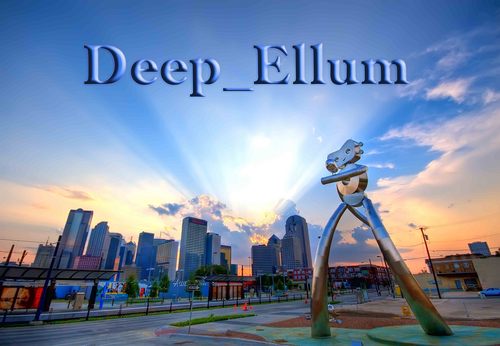Electrons and neutrons circle around a core;
All the humans rally round their leaders;
From industrial complex to one of the coolest music scenes in the region, Deep Ellum in Dallas, Texas has always had a varied and sometimes turbulent history. The newness of so much real estate near downtown belies the long history of the Deep Ellum neighborhood. However, like countless similar urban neighborhoods across America, it continues to experience a cyclical ebb and flow in its birth, life, death and phoenix rebirth.
The area got its start in 1884 as a factory-oriented development, and later, in 1913, Henry Ford opened an assembly plant there. However, by the late 20’s and early 30’s, Deep Ellum had become distinguished as a prime jazz and blues hotspot. In 1937, a columnist described Deep Ellum as: “…[the] one spot in the city that needs no daylight saving time because there is no bedtime…[It is] the only place…where business, religion, hoodooism, gambling and stealing goes on at the same time without friction…”
By the 1950’s, Deep Ellum had become largely a warehouse and industrial district again, but during the 1960’s and 70’s, the large warehouses once again attracted artists and night club owners because of the cheap loft space. Eventually, businesses such as the Theater Gallery, Twilight Room, Clearview and The Gypsy Tea Room offered a broad cross-section of interests, musicians, visual artists, performance artists and theatre performers. By the 1980’s, groups such as the Deep Ellum Association, began pressuring the city of Dallas to upgrade the roads, lighting, and parking of the area. The decade afterward became the high point for Deep Ellum as Dallas’ liveliest entertainment district. The streets often were blocked off for events like the Deep Ellum Arts Festival and a vibrant culture emerged in the district.
However, by mid-2006, local papers had begun to report the near-demise of the neighborhood because most of the live music venues had closed, leaving mostly dance clubs, and radically altering the “feel” of the area. In 2007, the City Of Dallas encouraged large scale residential, multi-family dwelling construction in Deep Ellum, in hopes of making it more financially successful. However, construction founded out of this initiative has remained dormant.
Deep Ellum has struggled with a reluctantly-forgiving public perception; however, once again things are showing signs of turning around. The city of Dallas’ commitment to the area is evidenced by its construction of the DART Green Line rail to serve the area. DART estimates that in the coming years, more than 2,000 riders a day will use the Deep Ellum station at Baylor, spawning the need for new businesses in the area. Companies such as Partymaker, an upscale caterer, remain vibrant mainstays to the neighborhood. Music venues such as Arnetic, located at 2826 Elm Street, are opening once again, with a mind to reclaim Deep Ellum’s place in the Dallas nightlife scene.
One has only to look at North Oak Cliff, the Bishop Arts District, Uptown, the Design District, and north of Fair Park to see that real estate near downtown will always remain a tempting proposition for developers. If history does indeed loop, then certainly Deep Ellum will rise on the foundation of its past combined with the perseverance of its benefactors. Perhaps then a colorful new chapter can be written for the history of the district that will inspire future generations to not abandon the past because it is old, but to embrace it and integrate it with the new. Justin Atkinson
Sources: http://en.wikipedia.org/wiki/Deep_Ellum,_Dallas,_Texas http://www.dallasnews.com/sharedcontent/dws/bus/stories/091109dnbusdart.3b2db82.html
Copyright Justin Atkinson 2009






